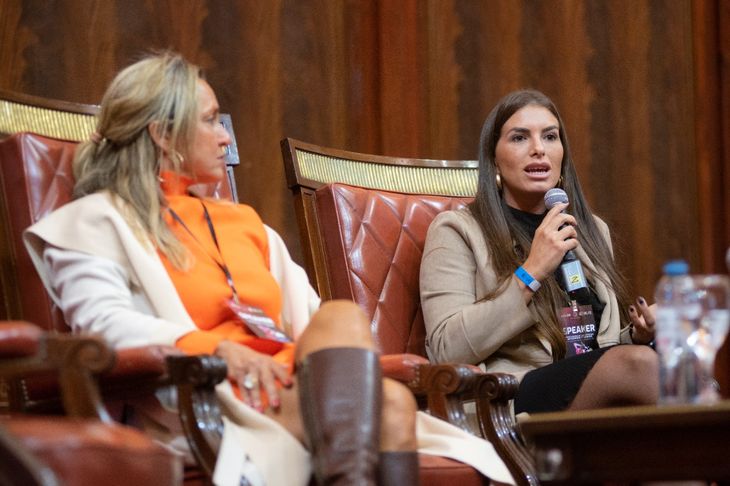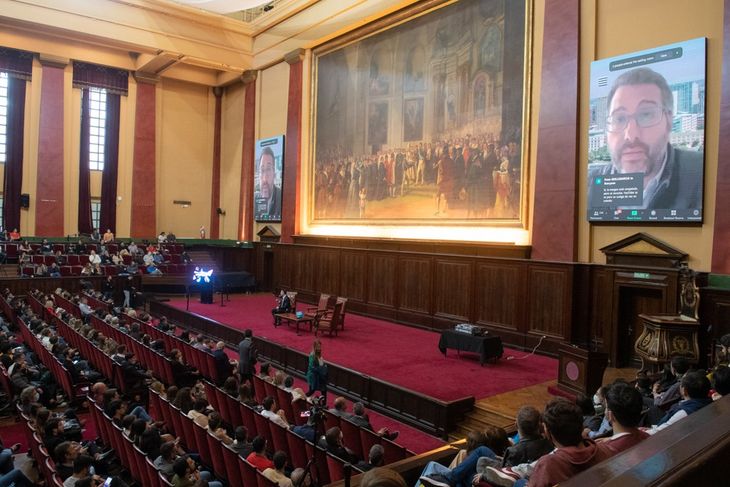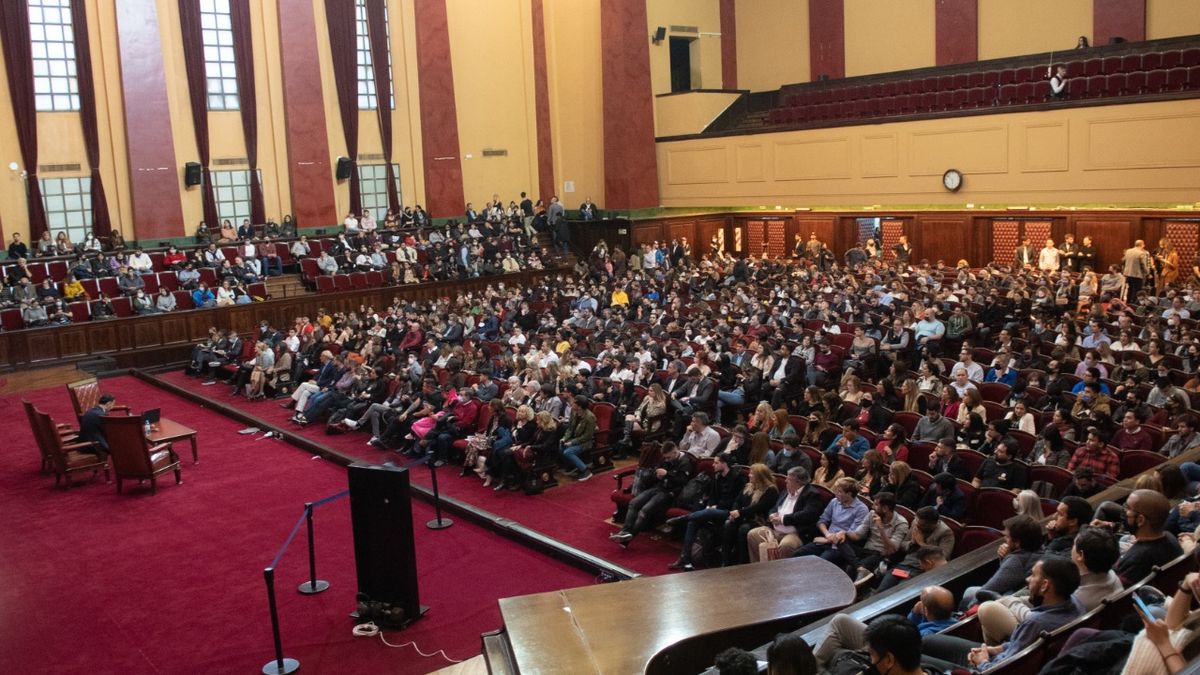Behind him remained impassive the foundation of the number one academic institution in Ibero-America, embodied in the imposing painting painted by Anthony Gonzalez Moreno in 1948.
Leandro Agostino, CEO of Scubalight, the video game studio that developed the prototype of the UBA Metaverse
Leandro Agostino, CEO of Scubalight, the video game studio that developed the prototype of the UBA Metaverse
But the kids from Mendoza, instead of looking back, chose to look forward. There were more than a thousand people in that iconic space, -and around fifteen hundred followed the event by streaming- and they were there, overflowing the place, excited to witness the launch of the UBA Metaverse: the creature that Leandro and Federico developed together with the Laboratory of Innovation and Artificial Intelligence of the university (UBA IALAB) headed byr Juan Corvalan.
Admittedly, by that time we had already had some visual and technological pyrotechnics with two extraordinary holograms projecting three-dimensional images of joysticks, the college façade, and words that twirled through the air.
It is even worth noting that, not without some technical failures, the event had started on time at 5:00 p.m. with Lee Ullman, Senior Director of MIT, explaining from the United States via Zoom the importance of Latin America taking the initiative regarding the Metaverse, especially of the hand of the Laboratory that promotes a unique innovation ecosystem in Spanish speaking.
However, we had even passed the time of the catering and the Metaverse was yet to be seen.
Daniela Dupuy and Agustina Pérez Comenale discussed legal aspects of the Metaverse

That is, not only had we not seen the development of the demo. Anxiety was breathed to understand what the issue of immersive, playful, virtual environments is all about. There was a desire to dive into the paradigm shift, to start speaking the language of digital entertainment linked to education, work, cities, everything.
So Leandro took the microphone, faced the audience and organized a wave like the one at the World Cups. “I don’t think ever in the history of this assembly hall has there been a wave!” Corvalán managed to notice, halfway between disbelief and laughter.
Of course, people shook, celebrated the idea, applauded and then the energy changed.
So much so that Corvalán was not, at that point, the only one surprised: Juan Manuel HaddadLegal Manager of Telefónica, could not believe that the place had been filled with a proposal that had nothing to do with the legal world: “We have Metaverse in Law School and people standing in the halls. Never seen” he repeated smiling.
Metaverse-UBA

Then, the side screens projected an avatar just got off the bus, at the stop on Figueroa Alcorta. He is a humanoid, a loosely defined species. He trots, he crosses the avenue, he reaches the steps, and there is a reception. A bunch of avatars partying; they have faces of dinosaurs, or of fantastic creatures that are difficult to identify.
And there it begins to become clear why to bet on the fashionable word: “Every time Juan says to me ‘hey, Leandro, why don’t we make people study in the Metaverse’, I answer him ‘come on, but let there be a teacher who talks about dinosaurs and then one appears in the virtual classroom, or that is three-dimensional, and eats the one who does not pay attention”.
“Whenever I can, I remind Leandro that we are at the UBA, that everything is fine, but let’s try not to blow up anything or kill anyone,” Corvalán managed to respond to the laughter of the audience.
And it is that to understand the Metaverse phenomenon we must look at the intersection between video games, Blockchain and devices that we can place in our body to deceive the senses: augmented reality or virtual reality glasses, headphones, haptic gloves.
But, from the sociological point of view, data that speak of global trends prevails: With the global COVID-19 lockdown, it was confirmed that a third of the world’s population plays virtual games.
At the same time, given the attention economy and the rise in average hours of mobile digital device use, companies are racing to make our minds stop on what they intend to convey to us. Therefore, the ability to concentrate dramatically decreases and this fully impacts education.
“For this reason, we -they raised from Scubalight- think that it is a very good idea to develop an immersive educational environment, in which the students recover their concentration because, as in video games, when you get involved you no longer pay attention to anything else. ”.
It seems incredible, but Generation Z, the first generation of pure digital natives, gamifies every aspect of their lives. In this segment, 90% of people play video games, and companies like SAP are looking for ways to make it fun, from recruitment to a job promotion, including staff training.
That is the data that the UBA IALAB took as a starting point to think about the Metaverse beyond technological fashion: change the way of conceiving the pedagogical processes, propose a new way of teaching and learning at a distance, marked by the symbolic construction that the new generations demand. It is to apply gamification so that the educational experience is enriched.
That way you get it Agustina Perez ComenaleBlockchain expert, member of the Binance Latam legal team, one of the most high-profile international speakers in Latin America.
When analyzing the qualities of the Diploma in Metaverse and Gaming that the UBA offers, it stands out: “It is the first program in the region to have its own Metaverse, which is in a beta phase but very soon to be used (…) To be able to talk about technologies, you not only have to study and understand, but also achieve practical experiences for students ”.
Corvalán, affirmed as an international benchmark for technological innovation, repeats almost like a mantra “we don’t want to be late again”.
It refers, of course, to the fact that in these latitudes we saw how Internet 1.0 passed us by, and then the explosion of mobile data, and later infinite storage in the cloud, and artificial intelligence such as the Fourth Industrial Revolution, which it still has ground to unfold, but it doesn’t seem to take up space on the agenda of the ruling class.
In a not exactly favorable national scenario, the UBA makes head of the beach with a risky bet but looking at education with the eyes of this century; thinking, first of all, of the young people who are now publishing their photos and videos of the holograms of the Metaverse on the networks; then, experts from the largest Spanish-speaking interdisciplinary ecosystem are looking to the future, and designing the education of those who have not yet reached high school.
For the latter, immersive virtual environments will probably be quite common. Local talent has two opportunities there: a vein of growth and economic development whose market is global and a space in which the interest of those facing higher studies may be amalgamated with the language they are used to.
What a task the UBA IALAB sets itself: to promote a paradigm shift (from analog to digital education, and from this to the Metaverse, in the words of Corvalán) in one of the areas most reluctant to change: education.
With the launch of the Diploma in Metaverse and Gaming and the gamified virtual environment itself, the UBA points the way in a scheme that brings together companies (in addition to Ámbito, Vorterix collaborated in the dissemination of the event), the academic-scientific sector and the State, just as today solutions to complex problems are designed.
It is, without a doubt, an auspicious start.
Source: Ambito
David William is a talented author who has made a name for himself in the world of writing. He is a professional author who writes on a wide range of topics, from general interest to opinion news. David is currently working as a writer at 24 hours worlds where he brings his unique perspective and in-depth research to his articles, making them both informative and engaging.




